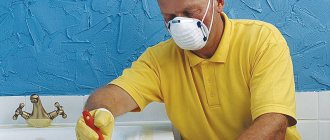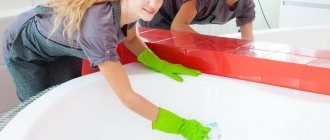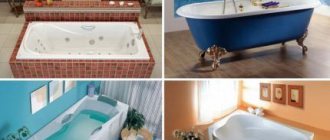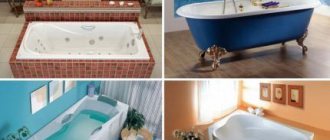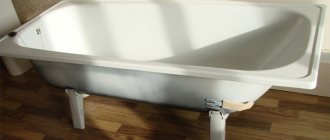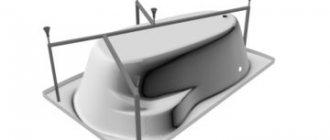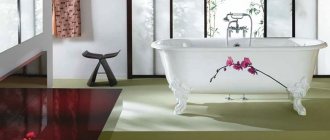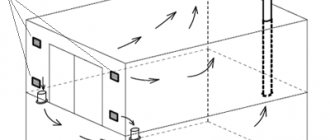Renovating a bathroom is not only a troublesome task, but also expensive. Quite often, after carrying out the most expensive renovations in the bathroom, there are still some shortcomings associated with replacing the plumbing. In most cases, the bathtub needs to be replaced, because during its use, over time, streaks and various kinds of defects associated with the natural aging of its coating begin to appear on its surface.
However, replacing a bathtub is an equally expensive undertaking, comparable only to carrying out renovation work in a room. Therefore, not every person has the opportunity to replace the bathtub in their bathroom. In this case, you can restore it yourself.
It should be noted right away that restoration is a simple and at the same time entertaining process that will return the original appearance to any product. To carry out the restoration, you will need bathroom enamel, as well as a minimum number of tools.
Comparative characteristics of bath enamels
When renovating a bathtub, some people prefer to use a so-called shell made of acrylic instead of resurfacing. However, it should be noted that replacing or updating the enamel coating is a cheaper way to restore a bathtub.
During the manufacture of the bath, the coating is applied to its surface when exposed to very high temperatures. Naturally, you won’t be able to renew the bathtub cover in this way yourself. However, thanks to the use of various enamels, the bathtub can be given its original appearance.
Before carrying out restoration work, first of all, you need to decide on the choice of coloring agent. There are many types of enamels on the modern market that are suitable for restoration work. The whole point of carrying out such work is to paint the previously prepared surface of the bathtub with a special composition. There are several different types of enamels that cope with updating the old bathtub coating:
- Epoxin – 51C.
- Glasscryl.
- Epoxin – 51.
- Reflex.
All these types differ from each other, both in their properties and characteristics. The compositions produced under the names Epoxin are two-component enamels that contain a hardener. After using epoxy, the restored bathtub can be cleaned using detergents or disinfectants.
If all application technologies and restoration work are followed, a bathtub updated with Epoxy can last more than 7 years. This product contains special ingredients that prevent the appearance of yellow streaks and stains on the bathtub.
Important! During restoration work, the bathtub can be given any color. To do this, you just need to add a tinting paste to the restoration enamel used, which is white.
The time for complete drying and hardening of Epoxin-51 enamel is at least 2 days, but the period for complete drying of Epoxin-51C is 24 hours. In addition, Epoxin-51C is not recommended to be diluted with any ingredients before applying it to the bath. A product called Epoxin-51, before application, can be diluted with a combined solution consisting of ethyl alcohol and acetone. The proportion of the dilution solution should be 1 to 1.
Reflex-50 is the most expensive product used during the restoration of bathtubs. It is a two-component product that contains a hardener. It is worth noting that Reflex-50 is one of the best bath paints, which will allow even the most complex restoration work to be carried out at a high level. However, the question arises, how long does it take for such bath enamel to dry? It should immediately be noted that its disadvantage is that the period of its final drying can reach up to 7 days.
Stacrylic is a material made from liquid acrylic. Unlike Epoxy, which, thanks to its properties, is able to fill and eliminate even the smallest defects on the surface of the bathtub, Stakryl itself is not able to cope with the removal of dents, scratches and chips. Therefore, before using it, the problematic surface of the bathtub must be puttied in advance. Glass hardens quickly, so you need to be careful when working with this material.
Attention! Liquid bathroom enamels are very toxic. Therefore, when working with them and when filling the bath with enamel, it is necessary to use personal protective equipment and exercise caution.
Consumption per 1 m?
The consumption of enamel when painting a bathtub primarily depends on the method of applying this material to the work surface. For example, when using a pneumatic gun, the consumption per 1 m2 of bath surface is 150 grams. If you use a brush when applying enamel to a bathtub, its consumption per 1 m2 of surface to be painted will be about 166 grams.
For a complete restoration of one bath, the recommended volume of enamel used is at least 700 grams. During restoration work, it is applied to the work surface in several layers. The number of recommended layers when carrying out restoration work is at least 2.
Whitening and polishing
The simplest and most energy-consuming way. Suitable only for darkened or yellowed products that do not have scratches or defects on the surface. For the procedure, you will need a bath cleaner, bleach, polishing paste, and a sander.
Progress:
- Rinse the coating thoroughly, removing all contaminants.
- Apply bleach to old enamel.
- Wait the required time and rinse off the substance with plenty of water.
- Sand the surface using a sander, starting with the coarsest sandpaper and ending with fine-grained sandpaper.
- Apply polishing paste to the surface.
Before the procedure, test the method on a small area; if no visible changes appear after treatment, you will have to use a more effective method of restoration.
Review of popular enamels for bath restoration
For high-quality restoration and restoration of the bathtub, first of all, you need to correctly select the right coloring agent. Indeed, in this case, the use of ordinary paints will not bring long-lasting and sustainable results. The enamel used to paint the surface of the bathtub must have increased resistance to sudden temperature changes. In addition, the materials used to restore the bathtub must be resistant to water and aggressive substances, such as detergents. During the restoration of bathtubs, epoxy enamels or so-called liquid acrylic are used.
Attention! It is best to paint the bathtub using a roller or brush. Waterproof bath enamels, which are available in the form of aerosols, despite their ease of use and high cost, do not have good durability and stability.
Aerosol enamel advantages and disadvantages
Enamels sold in aerosol cans are quick-drying paints that have good adhesion to any enamel coating. They are often used during restoration work to restore the coatings of bathtubs, boilers, refrigerators, sinks or sinks.
Aerosol enamel is easy to apply to damaged and scratched areas of any surface. To do this, you just need to shake the can a little before using it. However, such means have both their advantages and certain disadvantages. The advantages of aerosol products include:
- ease of use;
- easy to apply on uneven and rough surfaces;
- does not require the use of other tools during painting;
- copes excellently with updating old bathtubs made of cast iron or steel;
- provides a uniform and at the same time durable coating layer on the surface to be painted.
The disadvantages of aerosol enamels include low durability. After all, they contain a certain amount of solvents, thanks to which the paint can be sprayed as an aerosol. If applied incorrectly, after using the aerosol product, defects such as drips or uneven stripes may remain on the surface to be painted. In addition, one of the significant disadvantages of aerosol enamels is the high consumption during surface painting.
Types of aerosol enamels
Aerosol enamels are sold in special cans. The volume of the can can range from 140 to 520 milliliters. This can contains paint, gas, fillers and solvents. Aerosol products have a wide range of applications and are used for painting surfaces made of different materials (metal, plastic, etc.). There are several types of aerosol enamels, which differ in composition, scope of application, as well as functional characteristics:
- Decorative compositions.
- Compositions for painting metal products.
- Paints for coloring plastic products.
- Heat-resistant products.
- Aerosol enamels for baths.
- Universal compositions.
- Protective compounds.
- Special paints.
In the case of painting a large surface area, as a rule, several cans of such paint are used. It is very difficult to calculate the consumption of aerosol enamel per 1 m2 of surface to be painted. The fact is that consumption rates largely depend on the type of surface being painted. On average, the consumption of aerosol paint per 1 m2 is about 300 milliliters.
If you purchase several cans of paint, for example when painting a large surface area, it is recommended to buy products from one manufacturer. This is due to the fact that shades of paints of the same color, but from different manufacturers, may differ slightly from each other.
Acrylic
To carry out restoration work to restore old bathtubs, a material such as acrylic liquid bathroom enamel began to be used relatively recently (about 10 years). In terms of durability, it is in no way inferior to epoxy enamels. In addition, working with this tool is much easier. However, preparing it for use is a little more difficult than, for example, epoxy. This is due to the fact that the acrylic layer is a very viscous substance, and the hardener that is mixed with it is, on the contrary, liquid. Therefore, before using acrylic, it must be mixed for a long time and as thoroughly as possible until it becomes homogeneous.
The cost of acrylic is slightly higher than, for example, the price of the same epoxy. However, the advantage of this material is its good stability and durability.
Epoxy enamel
Epoxy bathroom enamel is a coloring substance that consists of several components - a hardener, as well as a base. Before using enamel, these components are combined with each other until a homogeneous, thick mass is obtained.
The cost of liquid epoxy enamels, compared to the same acrylic paints, is low. However, due to the fact that they have a viscous consistency, it is very problematic to apply them to the surface in an even, homogeneous layer. The period of final hardening and drying of epoxy can range from 48 hours to 3 days.
Restoration options for a cast iron bathtub
If it is not possible to purchase a new bathtub, then in this case you can restore the old cast-iron bathtub. There are several options that allow you to restore an old cast-iron bathtub and give it its original appearance:
- Replace the enamel coating.
- Install an acrylic liner.
- Use an enamel bath filler.
To replace the coating, you must use epoxy bathtub enamel or acrylic. Many people will immediately have a completely natural question: is it possible to paint a bathtub with ordinary enamel? Conventional paints should not be used to restore a bathtub, as they cannot cope with sudden temperature changes and gradually lag behind its surface.
The use of a so-called acrylic liner also allows you to restore an old cast iron bathtub. However, it will lose a little in its volume. After all, the thickness of the walls of such a liner is 6 mm, so if it is vital to preserve the volume of the restored bathtub, then in this case it is necessary to use only enameled bathtubs. In addition, the work to replace the enamel will be cheaper than using an acrylic liner.
How to remove stubborn stubborn stains
You need to learn the rules for caring for plumbing fixtures when purchasing them, since different materials have their own characteristics and requirements. Each bathtub material must be cleaned in different ways:
- Acrylic products that are now common require only special cleaning products. Acrylic cannot be cleaned with abrasive or caustic agents, and some bathtub models cannot tolerate chlorine-containing substances. Such acrylic care products are quite expensive and this is their main drawback.
- Some household chemicals contain soft cleaning agents that are difficult to remove rust stains and limescale. To remove such stains, special products are required. They can be used on a wide variety of surfaces.
- Aggressive products for removing stubborn stains and dirt. They can remove absolutely all types of stains, but they have a negative effect on the enamel of the bathtub and can damage it with regular use.
Step-by-step instructions for applying enamel
Before applying enamel, the surface of the bathtub must be cleaned of dirt using active detergents and water. Then it must be treated with an abrasive and the old layer of paint must be removed. This is necessary to create the necessary microrelief on an already cleaned surface.
Then it is necessary to remove dust and degrease the surface on which the paint will be applied. Dust removal is done using a vacuum cleaner or a damp sponge. To degrease, you can treat the bath with liquid Sanox. It must be poured into the bathtub and rubbed over its surface using a household sponge. This stage of preparatory work directly affects the adhesion of moisture-resistant enamel to the surface of the bathtub.
After the surface of the bathtub has undergone initial preparation before carrying out restoration work, epoxy enamel can be applied to it, and then, if necessary, varnish can be used. To do this, the compound is pre-prepared in compliance with all the instructions described on the packaging of the coloring agent.
It is best to paint using a flute brush. To do this, you need to moisten it, and then draw a vertical strip, starting from the bottom of the bath and following to its edges. Then the applied enamel needs to be rubbed on the sides as thoroughly as possible.
Then the next strip is applied in the same way. However, when applying each new strip, it is necessary to overlap the already made rubbing by approximately 50% of its area. The bristles that come out of the brush during painting are removed using tweezers or a painting knife. During the painting process, you must not touch the already painted surface.
When painting, first apply the first layer of enamel to the surface of the bathtub, it is called a primer. Then, after 15 minutes, a second layer is applied, in the same direction and from the same place where the primer layer was applied. After painting, the bathroom must be locked indoors for at least 3 days.
Tools
To apply the coating and carry out restoration work on a cast iron bathtub, you will need a small number of tools. First of all, before carrying out work, you need to take care of your own protection. After all, as you know, enamels are toxic substances. Therefore, you need to stock up on a respirator and rubber gloves in advance. It is also advisable to purchase a special rubberized apron. Indeed, if it gets on the surface of the skin, the enamel can cause dermatitis.
Among the tools for applying paint, you will need a brush - a brush of at least 70 mm. The brush should be made from natural ingredients. It is best to purchase two brushes, in case one becomes unusable during painting. Also, for the initial treatment of the bathtub, you will need a Durex wheel, a grinding wheel and a special grinding attachment.
When painting a bathroom, you may need a paint knife or tweezers. They are needed to remove loose particles of bristle from the brush. Acetone or solvent No. 646 is used as a consumable, but white spirit cannot be used.
Ways to paint a bathtub
You can paint the room with epoxy or acrylic enamel. It should be noted that painting work using acrylic is much simpler. However, epoxy is much cheaper than acrylic. Painting can be done with a simple brush or even a roller. It is best to start painting on the tapering, elongated spirals of the bathtub, from their edges towards the drain.
You can also use so-called quick-drying aerosol products for painting. However, compared to epoxy or the same acrylic, they do not have a large margin of strength and reliability. When painting a bathtub, you can use a pneumatic tool, thanks to which the paint is evenly distributed on its surface.
Painting Tips and Tricks
When painting a bathtub, drips or sagging may appear on its surface, which must be removed periodically during painting. Drips are removed with a brush stroke in an upward direction until they are completely smeared on the surface. The sagging that forms on the edge of the drain hole can be cut off using a painting knife after the enamel has hardened.
In the case of self-painting of a steel bathtub with three-layer enamel, or polymers, it is best to use bulk liquid acrylic. This is due to the fact that this material is the easiest to apply to the surface to be painted, and it does not dry out so quickly, making it possible to remove drips and sagging in a timely manner. It is recommended to apply quick-drying bath enamel as carefully as possible so that there are no smudges after painting, as it sets very quickly.
Video of bathtub restoration with enamel
The process of restoring a bathtub does not take a lot of time and effort. All that is needed to carry out restoration work is the availability of all the necessary tools and materials, as well as compliance with all instructions for the use and application of enamel. You can learn more about the restoration process and learn how to paint a bathtub at home with enamel by watching the corresponding video. By also watching the training videos, you can learn in more detail the steps of painting a bathtub with enamel yourself. Also, by watching training videos, you can get acquainted with people's reviews of different bath enamels.
Review of popular manufacturers
There are not many proven and reliable products that can be used when restoring bathtubs. The thing is that most companies, during production, use compounds that are not suitable for carrying out restoration work to restore the bathtub. In addition, most products from different manufacturers differ in composition. It is the composition of the enamel restoration product that affects the method of its application and the amount of time required for it to dry.
Epoksin 51 or Epoksin 51C are excellent for restoring the enamel coating. Random House products also performed excellently when restoring damaged enamel and restoring bathtubs. It is worth noting that Random House is a domestic manufacturer, which is represented on the market by such best bathroom enamels as Fantasia and Svetlana.
Preparation for repair
For work, buy a ready-made kit , which includes tools and devices for repairing chipped bathtubs.
The set contains:
- putty of a special composition;
- emery of different sizes;
- aerosol can with enamel for restoration and enameling.
To work you will need tools:
- brush (size is chosen according to the size of the crack);
- spatula, a soft one made of plastic or rubber is better;
- container for mixing putty.
Preparing the area to be treated is as important as applying putty and enamel. First, degrease the application area, then rinse and wait for it to dry, speeding up the process with a hairdryer. If you skip this operation, the putty will not adhere well to the metal.
Anti-grease detergent, acetone solvent, baking soda - to clean dirt and insoluble soap deposits you will need a grease-dissolving composition . You can buy products containing acids, for example, oxalic acid.
Under the putty, the chip is cleaned with sandpaper, small irregularities are removed so that the particles do not interfere with adhesion to the repair compound.
